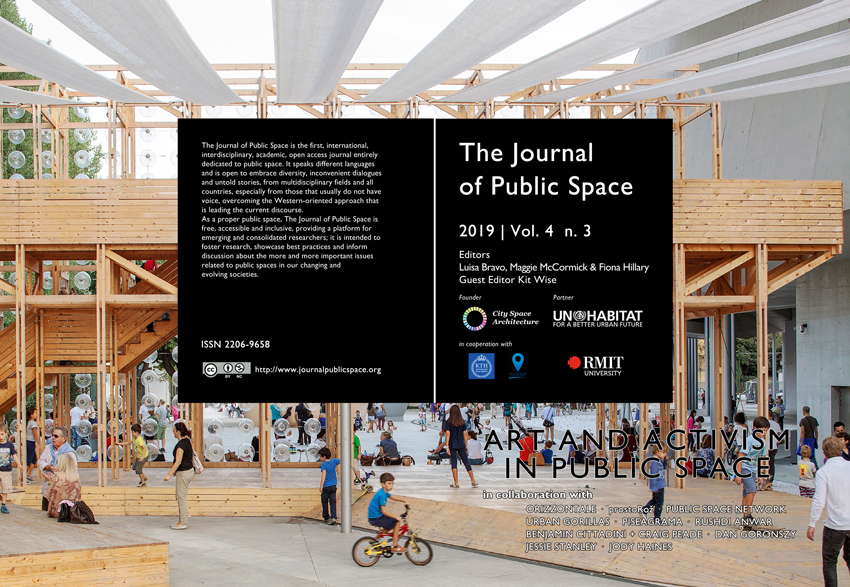The Making of ‘Good’ Mirrors: Art and Activism in Public Space
##plugins.themes.bootstrap3.article.main##
Abstract
This article, The Making of ‘Good’ Mirrors: Art and Activism in Public Space, discusses the Feminist and Indigenous methods I apply to co-created collaborative and relational portraiture projects expressly created for public space and semi-public space and how they act as art and activism. The discussed projects, created using still and moving image, work in resistance to the problem of the gendered aesthetic within the Australian context through the applied making methods within a social studio, the politics of representation and the public placement of the project’s products. Discussed projects include #IAMWOMAN (2017-current), Women Dreaming (2018) and Flipping the Script (2018).
##plugins.themes.bootstrap3.article.details##
The Authors retain copyright for articles published in The Journal of Public Space, with first publication rights granted to the journal.
Articles in this journal are published under the Creative Commons Attribution NonCommercial Licence (CC-BY-NC) - https://creativecommons.org/licenses/by-nc/4.0/.
You are free to:
• Share - copy and redistribute the material in any medium or format
• Adapt - remix, transform, and build upon the material
Under the following terms:
• Attribution - You must give appropriate credit, provide a link to the license, and indicate if changes were made. You may do so in any reasonable manner, but not in any way that suggests the licensor endorses you or your use.
• NonCommercial — You may not use the material for commercial purposes.
References
Ahmed, S. (2017). Living a feminist life, Durham, Duke University Press.
Azoulay, A. (2016). Photography Consists of Collaboration: Susan Meiselas, Wendy Ewald, and Ariella Azoulay. Camera Obscura: Feminism, Culture, and Media Studies, 31.1 91, 186-201.
Berger, J. (1972). Ways of Seeing, UK, Penguin Books.
Bessarab, D. & Ng'andu, B. (2010). Yarning About Yarning as a Legitimate Method in Indigenous Research. International Journal of Critical Indigenous Studies, 3, 37-50.
Brooks, D. E. & Hébert, L. P. (2006). Gender, race, and media representation. Handbook of gender and communication, 16, 297-317.
Budarick, J. (2018). Media outlets are racialising Melbourne's 'African gang' problem. The Conversation, August 1.
Cotter, D. J., George, M. & Graeves, D. M. (2017). RE: Congratulations, Immerse 2017 Emerging Artist Award. Type to Haines, J. November 11.
Darian-Smith, K. (2016). The ‘girls’: women press photographers and the representation of women in Australian newspapers. Media International Australia, 161, 48-58.
Dobson, A. S. (2015). Postfeminist Digital Cultures Femininity, Social Media, and Self-Representation, USA, Palgrave Macmillan US.
Dunleavy, J. n.d. About Yarning Circles: A Guide for participants [Online]. On line: GNIBI Southern Cross University. Available: https://www.scu.edu.au/media/scueduau/academic-schools/-gnibi-college-of-indigenous-australian-peoples/About-Yarning-Circles-A-Guide-for-Participants.pdf [Accessed August 2019 2019].
Edelman, M. W. (2015). It’s hard to be what you can’t see [Online]. On Line: Children’s Defense Fund. Available: https://www.childrensdefense.org/child-watch-columns/health/2015/its-hard-to-be-what-you-cant-see/ [Accessed May 2018 2018].
Finkelstein, R., Ricketson, M. & Australia Department of Broadband, C. A. T. D. E. (2012). Report of the independent inquiry into media and media regulation. Canberra.
Fredericks, B., Adams, K., Finlay, S., Fletcher, G., Andy, S., Briggs, L., Briggs, L. & Hall, R. (2011). Engaging the practice of Indigenous yarning in action research. ALAR: Action Learning and Action Research Journal, 17, 12-24.
Greenberg, J. (2018). The Female Lens. TEDx, 2018 Wabash College USA. Online: TEDx Talks.
Hadland, A., Lambert, P. & Barnett, C. (2016). The state of News Photography 2016. online: University of Stirling and World Press Photo Foundation.
Haines, J., Galuak, A., Akon, A., Basutu, T., Olubodun, O., Kulong, A., Makur, R., Yona, B., Mayen, N., Kollie, J., Ruach, N., Kabasha, L., Kitungano, M., Rual, A., Balla, R., Ali Bakhit, S. & Dawd, S. (2018a). FACES ACROSS AFRICA (AFRICA…NOT A COUNTRY).
Haines, J., Mayen, N. & Basutu, T. (2018b). For you.
Haines, J. & Olubodun, O. (2018). Don’t Touch my hair.
Hooks, B. (1992). Black Looks: Race and Representation, USA, South End Press.
Lorde, A. (2017). Your silence will not protect you, UK, Silver Press.
Luvera, A. (2010). Residency. photographies, 3, 225-241.
Luvera, A. (2019). Then with Now. Photography for whom?, 1, 5-9.
Marshallsea, T. (2017). Why doesn't Australia have an indigenous treaty? [Online]. Online: BBC. Available at: http://www.bbc.com/news/world-australia-40024622 [Accessed 2018].
Martin, B. (2018). Platforms of Indigenous Knowledge Transference. In: OLIVER, J. (ed.) Associations. Creative Practice and Research. Australia: Melbourne University Press.
Mignolo, W. (2009). Epistemic Disobedience, Independent thought and De-colonial Freedom. Theory, Culture & Society, 26, 1-23.
Mulvey, L. (1975). Visual Pleasure and Narrative Cinema. Screen. Screen.
Palmer, D. (2013). A Collaborative Turn in Contemporary Photography? photographies, 6, 117-125.
Sebag-Montefiore, C. (2019). Women battling sexism in photography – a picture essay. The Guardian, 07 March 2019.
Sontag, S. (1971). On Photography, USA and Canada and Great Britain, Penguin Books.
Stoneham, M., Goodman, J. & Daube, M. (2014). The Portrayal of Indigenous Health in Selected Australian Media. The International Indigenous Policy Journal., 5, 1-13.
Turnbull, G.-R. (2015). Surface tension. Navigating socially engaged documentary photographic practices. Nordicom review, 36, 79-96.
Wells, L. (2005). Women and Photography. Oxford University Press.

